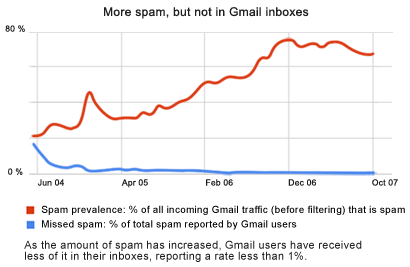 It takes the average person 5 seconds to identify and delete a single spam message. While that may not sound like much, all those seconds add up.
It takes the average person 5 seconds to identify and delete a single spam message. While that may not sound like much, all those seconds add up.
If you’ve got better things to do than delete spam, consider Gmail. Our users report getting almost no spam, leaving them with more time to do things they enjoy, like learning a new language, or giving that special someone an extra hug.
What makes Gmail’s spam filters work so well?
[kml_flashembed movie="http://www.youtube.com/v/8FVme_xIRYk" width="425" height="350" wmode="transparent" /]
Gmail uses Google’s innovative technology to keep spam out of your inbox.

Gmail fans often cite great spam protection as a key reason they love Gmail. It’s relatively easy to catch spam messages; the challenge is to catch the right messages without blocking mail you want along the way.
How do we do it? Our team of leading spam-fighting scientists uses a number of advanced Google technologies. Though in many cases our best weapon is you.
Community clicks
Gmail users play an important role in keeping spammy messages out of millions of inboxes. When the Gmail community votes with their clicks to report a particular email as spam, our system quickly learns to start blocking similar messages. The more spam the community marks, the smarter our system becomes.
Quick adaptation
The same advanced computing infrastructure that powers Google search also tunes our spam filters. As new spam data is released, the scale of Google’s computer network allows us to quickly modify Gmail’s spam-fighting algorithms. It’s often a matter of minutes between the time a spammer sends out a new type of junk mail and when it’s blocked from Gmail accounts.
Powered by Google
Many Google teams provide pieces of the spam-protection puzzle, from distributed computing to language detection. For example, we use optical character recognition (OCR) developed by the Google Book Search team to protect Gmail users from image spam. And machine-learning algorithms developed to merge and rank large sets of Google search results allow us to combine hundreds of factors to classify spam.
Authentication, for everyone
Many webmail services support a single authentication system to verify senders and help identify forged messages. Gmail supports multiple authentication systems, including SPF (Sender Policy Framework), DomainKeys, and DKIM (DomainKeys Identified Mail), so we can be more certain that your mail is from who it says it’s from. Also, unlike many other providers that automatically let through all mail from certain senders, making it possible for their messages to bypass spam filters, Gmail puts all senders through the same rigorous checks.
[tags]Google, Technology, Junk Mails, Spam, Software Giant, tips, tricks[/tags]
